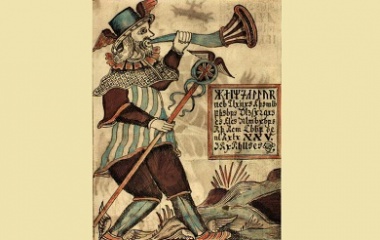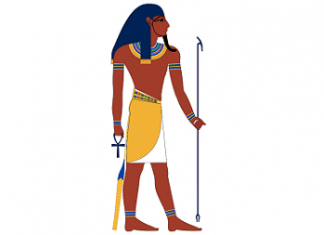- Pronunciation: HAME-doll
- Origin: Scandinavia
- Role: Watchman
- Symbols: Gjallarhorn (trumpet)
- Parents: Odin and Nine Maiden Sisters
Who is Heimdall?
In the beginning of the Norse mythological tale, there were only forests and overgrown areas of land. A clan of gods known as the Aesir cleared the land in the middle of the world where the humans would live and called it the Midgard. They also built a high place for themselves: the Asgard.
The Bifrost, a rainbow bridge, is the main road to the kingdom of heaven. It spans from the Midgard to the Asgard. The specially gifted Heimdall, chosen for his unique abilities, is the appointed guardian of the Bifrost. He protects the heavens of Asgard from giants, the enemies of the gods.
The watchman Heimdall needs minimal sleep and has heightened senses. Heimdall can see far into the distance, even in the dark of the night, and can hear sounds as soft as that of the grass growing.
Origin
Aesir (Ice-ear) is a word from the Old Norse language and means multiple gods. The Aesir are a clan of famous deities, namely, Odin, Thor, Frigg, Tyr, Loki, Baldur, Idun, Bragi, and Heimdall. The home of the Aesir tribe, the Asgard, is the highest of Nine Worlds connected by the mythological tree called the Yggdrasil. The Aesir are the personalities of the forces of nature, and the powers that hold the cosmos together.
Heimdall lives in a dwelling called Himinbjörg – which means “sky cliffs” – at the top of the Bifrost. As guardian, he is equipped with a Gjallarhorn ready to sound when intruders are approaching. When the horn is played, it can be heard throughout the worlds.
Family of Heimdall
Parents
Heimdell is the son of nine maiden sisters known as the Nine Undines, or the Nine Waves. This is perhaps the reason he was born with so many gifts. The nine sisters were known to be both beautiful and terrible. Their names represent the various powers of the ocean. The two oldest sisters are twins, Duva, the Hidden One, and Kolga, the Cold One. The next sister is Blodughadda, the red haired and bloodthirsty sister. Her name represents red sea foam. Next comes Bara, which means foam fleck, signifying the moment that a wave hits the shore. Bylgja meaning billow, or breaker, is next, followed by Hrǫnn, or welling wave, and her twin Hefring, rising wave. Finally are Unn, frothing wave, and the youngest Himinglava, transparent wave.
The father of Heimdall is Odin, chief of the Aesir tribe. Legend has it, that the love between the nine maiden sisters was like no other. Their alliance was resolute. Therefore, when one of them chose to lay with Odin, against the wishes of their father Aegir (the god of the sea), the other eight sisters stood by her to cover up her defiance.
There is another theory about the many mothers of Heimdall. Some believe that Odin bedded all nine of the sisters. This option would have been quite courageous on his part, considering that the maidens were nine bloodthirsty mermaids. Either way, at least one of them became pregnant with Heimdall.
Children
Heimdall is deemed the father of all people. Before he was charged with being the watchman of the Bifrost, he traveled the world, visiting various married couples. He stayed with each couple for three nights. The first couple were serfs, the next were poor farmers, and the last couple were nobility. Nine months after each visit, a child was born.
Thrall was the child born first; he was ugly, but very strong and he became the ancestor of all serfs. The next child was Karl. He was a skilled farmer and became the ancestor of all peasants. The third was Jarl, the ancestor of warriors and nobles. He was intelligent and skilled at hunting and combat.
The Doom of the Gods
Ragnarok is the Norse word for “the doom of the gods”, which is the end of the mythological cycle. It was at this time that the cosmos was destroyed and later re-created.
For many years, the prophecies predicted the reign of the gods and goddesses would end. The humans in Midgard were increasingly becoming listless, apathetic and agnostic. Additionally, the gods and goddesses had quite unbecomingly broken their oaths during the Fortification of the Asgard. There was a looming eventuality that the cosmos would fall.
Balder, the god of love and justice, was killed by the scheming and two-faced minor god Loki, and was now confined to the underworld. Loki and his gigantic wolf son, Fenrir, were imprisoned and chained to prevent them from doing further damage. Odin, the head god and father of Heimdall, chose the strongest human warriors and prepared them to join in the upcoming battle against the world-destroying giants. The gods were preparing, but in their hearts they knew that the end was inevitable and the worst was yet to happen.
As predicted, the time had come: the beginning of the end. First, the Fimbulwinter arrived, a mighty winter with snow that fell from every direction. The brutal winter lasted for three years straight without the usual break for the summer season. Next, the wicked Loki and Fenrir broke free of their chains. The great tree Yggdrasil began to shake and tremble. It was no longer able to hold the Nine Worlds together as strongly as before.
Heimdall spotted an army of giants headed toward the Asgard. He could see in the distance the scandalous escapee Loki standing at the helm of the Ship of the Dead that was quickly approaching.
Heimdall sounded his horn to warn the gods! From all corners of all worlds, gods, giants, elves, dwarves and demons met for the final battle on the plain of Vigrid.
The evil giants began their destruction of the Asgard and then expanded to all of the other worlds. Fenrir, the giant wolf, ran across the worlds with his lower jaw dragging along the ground and his upper jaw in the sky, eating everything in his path. The sun was pulled down from the sky and eaten by the savage beast. Subsequently, his brother Hati ate the moon and left the Earth in total darkness.
The gods put up a valiant fight. Each of them was matched in the war with a giant. Heimdall fought the final battle against his long time enemy, Loki. In the end, neither survived.
A giant called Surt swept a flaming sword across the Earth, causing an inferno like the fires of hell. All nine of the worlds burned, and almost everyone perished. The Earth sank into the sea. Creation had been reversed, and what was left was endless darkness and silence. Ginnungagap, the Void.
Following the destruction, a new and ideal world rose from the sea. Balder was released from the underworld. Two humans were spared and began to repopulate the world. All prior misery and wickedness no longer existed. A few gods survived, while others were reborn. All was good and right again for gods and humans.
Modern Influence
A continued fascination with the character of Heimdall, and the other Norse gods and their stories, is evidenced by the many books, comics, movies and games that are based on Norse mythology and its characters today.
Heimdall first appeared in a Marvel Comic called Journey into Mystery #85 in 1962. Now considered a classic comic collectible, a copy in pristine condition currently sells for $4,000 to $5,000 on eBay. The Yu-Gi-Oh game has a “Heimdall the Guardian of the Bifrost Bridge” card typed as a warrior and played as an Asgardian.
Heimdall is a featured character in numerous Avenger and Thor movies and television series. Actor Idris Elba portrays Heimdall in several of the recent Marvel films and continues with the role in the 2017 movie, Thor: Ragnarok.










